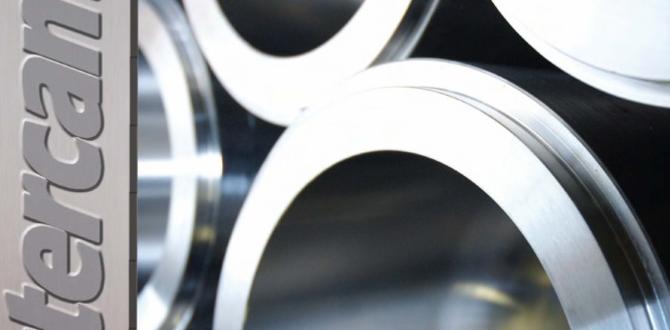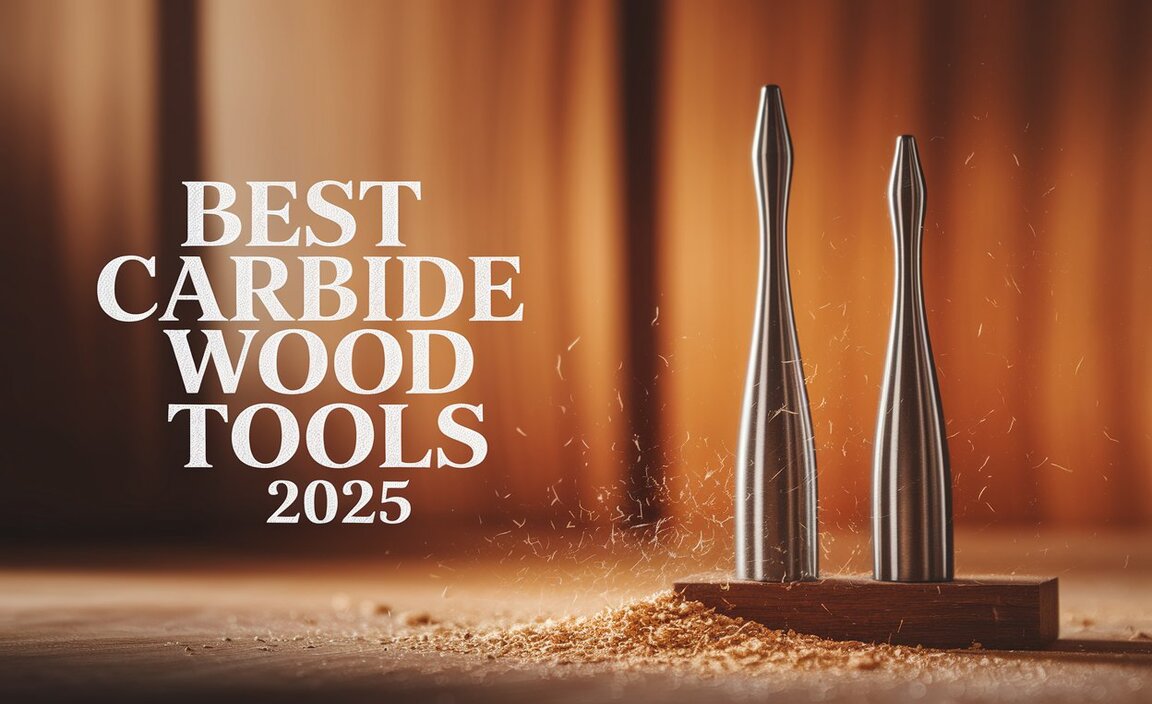A 3/16 inch carbide end mill with a long reach shank is your key to accessing deep pockets and complex shapes in your projects. It’s perfect for materials like ¾ inch acrylic or aluminum, offering stability and precision where standard end mills can’t go.
Hey folks, Daniel Bates here from Lathe Hub! Ever found yourself staring at a workpiece, wishing your milling tool could just reach a little further? That’s a common challenge, especially when you’re diving into projects with deeper cuts or intricate internal features. It can be frustrating when your standard end mill just doesn’t have the reach. But don’t worry, there’s a fantastic solution that brings precision and power right to where you need it: the 3/16 inch carbide end mill with a long reach shank. I’m going to walk you through what makes these tools so special and how you can use them to unlock new levels of creativity in your workshop.
Why a Long Reach Carbide End Mill?
When you’re working with metal or plastics, especially in hobbyist or DIY settings, you often encounter situations where you need to mill into a component deeply. Trying to do this with a standard end mill can lead to a few problems:
Chatter and Vibration: If the cutting tool extends too far from its holder, it can start to vibrate. This is called chatter, and it leaves a rough, unusable surface finish. It’s like trying to strum a guitar with a really long, bendy pick – the sound is all wrong!
Tool Breakage: Excessive vibration and flex put a lot of stress on the cutting tool. This greatly increases the risk of the end mill snapping off inside your material, which can ruin your part and damage your machine.
Limited Access: Some designs simply require a tool that can reach into areas that a standard length tool cannot. Think of milling out a deep cavity or a tight corner inside a part.
This is where the long reach carbide end mill shines. It’s specifically designed to overcome these limitations, giving you the clearance and stability needed for those challenging jobs.
Understanding the 3/16 Inch Carbide End Mill
Let’s break down the key components of this tool:
Carbide: This is a super-hard material, usually tungsten carbide. It’s incredibly wear-resistant and can handle higher cutting speeds and temperatures than traditional high-speed steel (HSS) tools. This means they stay sharper for longer and can cut through tougher materials more efficiently. For your workshop, this translates to better performance and durability.
3/16 Inch Diameter: This is the cutting width of the end mill. A 3/16 inch size is versatile for many applications, offering a good balance between material removal rate and the ability to create fine details. It’s a popular size for many DIY projects.
Long Reach Shank: This is the defining feature. The shank, the part of the end mill that grips into your machine’s collet or tool holder, is significantly longer than a standard end mill. This extra length allows the cutting flutes to extend further from the spindle, enabling you to reach deeper into your workpiece without the tool holder getting in the way.
Benefits of Long Reach for Specific Materials
The combination of carbide hardness and the extended reach makes this tool ideal for specific materials:
Acrylic: Many acrylic projects require deep cuts or specific pocket depths. A 3/16 inch long reach carbide end mill can make clean, chip-free cuts in acrylic without melting or chipping. For materials like ¾ inch acrylic, the longer reach is often essential for getting full depth.
Aluminum: Aluminum is a popular choice for many machinists due to its machinability and strength. This end mill can efficiently remove aluminum while maintaining a good surface finish, even in deeper cuts. The MQL (Minimum Quantity Lubrication) friendly design often found on these tools helps keep the aluminum from gumming up the flutes.
Plastics: Beyond acrylic, many other plastics can be machined. The sharpness of carbide and the controlled cutting of an end mill provide excellent results.
Key Features to Look For
When you’re shopping for a 3/16 inch long reach carbide end mill, here are a few things to keep your eyes peeled for:
Number of Flutes:
2 Flutes: These are generally preferred for softer materials like aluminum and plastics (including acrylic). They have more chip clearance, which helps prevent the material from clogging up the flutes and causing melting or poor surface finish.
4 Flutes: Better suited for harder materials or when a finer finish is desired in aluminum. They offer more cutting edges for a smoother cut but have less chip clearance.
Coating: Some end mills come with coatings (like TiN – Titanium Nitride, or TiCN – Titanium Carbonitride) to further enhance hardness, reduce friction, and improve tool life. For general use, an uncoated carbide end mill is often sufficient.
Shank Length: This is crucial for a “long reach” tool. Manufacturers will specify the total length and the length of the shank sticking out past the holder. Ensure it’s long enough for your specific application.
MQL Friendly Design: Many modern long reach end mills are designed to work well with MQL systems. These systems spray a fine mist of coolant and lubricant onto the cutting area. This is fantastic for keeping tools cool, reducing friction, and clearing chips, especially in materials like aluminum and acrylic. It significantly improves tool life and surface finish. You can learn more about Machining Lubrication at the Machining Help MQL Guide.
End Type:
Square End: The most common type, creates flat-bottomed pockets and sharp corners.
Ball End: Creates rounded internal corners and is used for profiling or contouring.
Example Specifications Table
Here’s a look at how specifications might be presented. This can help you compare different options:
| Feature | Option A | Option B | Option C |
|---|---|---|---|
| Diameter | 3/16 inch (4.76mm) | 3/16 inch (4.76mm) | 3/16 inch (4.76mm) |
| Shank Diameter | 3/16 inch (4.76mm) | 1/4 inch (6.35mm) | 3/16 inch (4.76mm) |
| Flutes | 2 | 4 | 2 |
| Overall Length | 3 inches (76.2mm) | 4 inches (101.6mm) | 2.5 inches (63.5mm) |
| Reach from Holder (approximate) | 1.5 inches (38.1mm) | 2.5 inches (63.5mm) | 1 inch (25.4mm) |
| Material | Solid Carbide | Solid Carbide | Solid Carbide |
| MQL Friendly | Yes | Yes | No |
Note: “Reach from Holder” is an approximation and depends on your collet and how far the tool can reasonably extend without excessive deflection.
When to Use Your 3/16 Inch Long Reach End Mill
This tool isn’t for every job, but it excels in specific scenarios:
Milling Deep Pockets: When you need to mill a pocket that is deeper than your standard end mill can reach without risking chatter.
Creating Internal Features: Machining slots, channels, or cavities within a part where clearance is limited. The long shank provides access without the spindle housing interfering.
Profiling Tall Parts: Cutting around the outside profile of a tall or thick workpiece.
Working with Thin Materials: While it might seem counterintuitive, long reach can sometimes help when working with thin materials to achieve a specific depth without multiple passes or risking the tool holder hitting the material.
Machining ¾ Inch Acrylic: As mentioned, ¾ inch acrylic is a common material where this tool proves its worth. It allows you to plunge and cut to full depth cleanly.
Setting Up Your Long Reach End Mill for Success
Proper setup is crucial for any machining operation, but especially when using tools that extend further from the spindle.
1. Machine and Tool Selection
Machine Rigidity: Ensure your milling machine is robust enough. A lighter-duty machine or one with excessive play in its axes will amplify vibrations when using a long reach tool.
Collet/Tool Holder: Use a high-quality, clean collet or tool holder. A worn or dirty holder can introduce runout (wobble), which will ruin your cut. For long reach, consider a holder that offers good support or a collet chuck for better concentricity along the shank.
Tool Condition: Inspect your end mill for any signs of damage, wear, or chipping. A sharp, undamaged tool is essential for good results and safety.
2. Tool Engagement and Depth of Cut
This is where it gets a bit technical, but don’t worry, we’ll keep it simple.
Radial Depth of Cut: This is how much of the tool’s diameter is engaged in the material at any given time. For long reach end mills, especially in materials prone to vibration like acrylic, it’s often best to use a lighter radial depth of cut. This means you’re not taking a massive bite of material from the side.
Rule of Thumb: For 3/16 inch end mills, aim for a radial depth of cut that’s about 30-50% of the tool diameter. So, for a 3/16 inch tool, this would be roughly `(3/16) 0.3` to `(3/16) 0.5` inches, or about `0.056` to `0.094` inches.
Axial Depth of Cut (Depth per Pass): This is how deep you plunge the tool into the material on each pass. For long reach tools, it’s vital to be conservative.
Acrylic: Start shallow, maybe `0.05` to `0.1` inches per pass. You can always increase it if the cut is clean and chatter-free.
Aluminum: You can often go deeper, but again, watch for chatter. Start with `0.1` to `0.2` inches and adjust.
Climb Milling vs. Conventional Milling:
Climb Milling: The cutter rotates in the same direction as it feeds into the material. This generally produces a better surface finish and puts less side load on the tool. It’s often preferred for aluminum and plastics. Set your machine to climb mill if possible. If you’re unsure about your CNC’s capabilities or setup for climb milling, consult your machine’s manual or a trusted machining resource like CNCCookbook’s Guide to Milling.
Conventional Milling: The cutter rotates against the direction of feed. This can work, but it tends to push material ahead of it and can lead to more tool wear or a rougher finish. Always prioritize climb milling if you can.
3. Speeds and Feeds
This is perhaps the most critical part. Getting the speeds and feeds right will make or break your cut.
Spindle Speed (RPM): This is how fast your spindle rotates.
Feed Rate (IPM – Inches Per Minute): This is how fast the tool moves through the material.
There are many calculators online, but a good starting point for a 3/16 inch 2-flute carbide end mill in:
Acrylic (¾ inch thick):
Spindle Speed: 12,000 – 18,000 RPM (lower end for rigid machines, higher for more high-speed spindles)
Feed Rate: 15 – 40 IPM (start on the lower end, increase if chatter-free)
Aluminum (e.g., 6061):
Spindle Speed: 9,000 – 15,000 RPM
Feed Rate: 20 – 50 IPM
Important Considerations:
Acoustics: Listen to your cut! A smooth, consistent sound is good. Squealing or chattering means something is wrong – usually too fast a feed rate, too slow a spindle speed, or too deep a cut.
Chip Formation: Watch the chips. For aluminum, you want small, curly chips. For acrylic, you want slightly larger, thin chips – not melted goo.
Coolant/Lubrication: If using MQL, ensure the mist is hitting the cutting edge effectively. This will help evacuate chips and keep the tool cool, especially in aluminum.
Manufacturer Recommendations: Always check if the end mill manufacturer provides recommended speeds and feeds for specific materials.
Safety First!
Working with any cutting tool requires caution. With a long reach end mill, there are a few extra points to remember:
Secure the Workpiece: Make absolutely sure your workpiece is clamped down securely. A long reach tool can exert forces that might dislodge improperly secured material.
Eye Protection: Always wear safety glasses. Flying chips are dangerous.
Machine Enclosure: If your machine has an enclosure, use it. It helps contain chips and coolant.
Clearance: Be aware of the long reach of the tool. Ensure it won’t collide with anything it shouldn’t, especially when moving in different axes. Double-check your toolpaths in your CAM software.
Start Slow: When in doubt, always start with slower speeds, shallower depths, and lighter feed rates. You can incrementally increase them once you’re confident the cut is stable.
Step-by-Step Example: Milling a Deep Pocket in ¾ inch Acrylic
Let’s imagine you need to mill a small, deep pocket (say, 0.5 inches deep) into a piece of ¾ inch thick acrylic. Your standard end mill won’t reach comfortably.
Tools You’ll Need:
CNC Mill
3/16 inch 2-Flute Long Reach Carbide End Mill (square end)
Collet Chuck or High-Quality Collet
Secure Workholding (e.g., clamps, double-sided tape, vacuum table)
Safety Glasses
Optional: MQL System and appropriate lubricant
Steps:
1. Prepare Your Material: Ensure your ¾ inch acrylic sheet is flat and securely clamped to your machine bed.
2. Insert the End Mill: Clean your collet or collet chuck and insert the 3/16 inch long reach carbide end mill. Tighten it securely.
3. Set Work Zero: Carefully set your X, Y, and Z zero points on the workpiece. Ensure your Z zero correlates to the top surface of the acrylic.
4. Program Your Toolpath:
Use a pocketing operation in your CAM software.
Tool: Select your 3/16 inch, 2-flute long reach end mill.
Depth: Set the total pocket depth to 0.5 inches.
Axial Depth per Pass: Set this to a conservative value, like 0.08 inches for ¾ inch acrylic. This means 26 passes (`0.5 / 0.08 = 6.25` passes, so you’d have 7 total passes, with the last one being slightly shallower).
Radial Depth of Cut: Aim for around 30% of the tool diameter, so approximately 0.056 inches.
Strategy: Select climb milling if available.
Speeds and Feeds: Based on our earlier suggestions, set your spindle to 15,000 RPM and your feed rate to 25 IPM.
Plunge Rate: Set this to be much slower than your feed rate, perhaps 10-15 IPM, to avoid shock loading the tool when it enters the material.
5. Engage MQL (If Used): Turn on your MQL system to mist the cutting area.
6. Run the Job:
Start the spindle.
Initiate the cut.
Listen and Watch: Pay close attention to the sound. Is it smooth? Are chips being ejected cleanly? Is the acrylic melting or forming a gummy mess?
7. Adjust as Needed:
Chatter: If you hear chatter, reduce the feed rate slightly or decrease the axial depth of cut.
Melting/Gummy Chips: If the acrylic is melting, you might be feeding too slowly, or your spindle speed might be too high for the feed rate. Try increasing the feed rate gradually or slightly decreasing RPM. Ensure your MQL is working.
* Clean Cut: If the cut is smooth and producing thin, clean chips, you can cautiously increase the feed rate or slightly deepen the axial cut on subsequent passes or for future jobs.
8. Completion: Once the pocket is milled to depth, stop the machine and admire your work. Ensure the end mill clears the workpiece before retracting.
This step-by-step process highlights how the long reach end mill enables you to achieve depths that would







